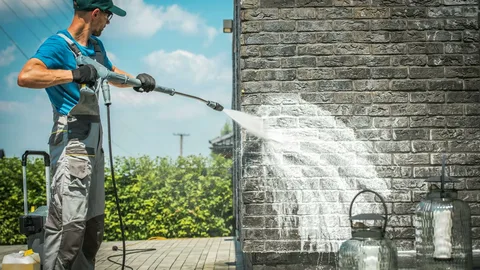Pressure washers are powerful tools that make cleaning faster and more effective—but the real magic lies in the nozzle. If you’ve ever wondered why some nozzles blast paint off a deck while others are safe for washing your car, the answer lies in the pressure washer nozzle chart.
Knowing how to read a nozzle chart isn’t just for pros. Whether you’re a DIY homeowner or a commercial cleaner, choosing the right nozzle can mean the difference between sparkling results and accidental damage. In this article, we’ll break down what the nozzle chart really means, how to use it, and why understanding PSI, GPM, and nozzle angle is essential.
What Is a Pressure Washer Nozzle Chart?
A pressure washer nozzle chart is a guide that matches specific nozzle sizes and spray angles to their intended use. It shows you what nozzle to use based on your pressure washer’s PSI (pounds per square inch) and GPM (gallons per minute).
It typically includes:
- Nozzle color codes
- Spray angles (measured in degrees)
- Recommended uses
- Pressure compatibility and flow rates
The chart helps you avoid guesswork and ensures optimal performance for your cleaning job.
Common Nozzle Colors and What They Mean
Color-coded tips are standard in the pressure washing industry. Each color corresponds to a specific spray angle:
- Red (0°) – A narrow, high-pressure stream for tough stains and hard surfaces. Best for removing paint or grease. Not safe for delicate surfaces.
- Yellow (15°) – Medium pressure for heavy-duty cleaning like concrete, driveways, or brick.
- Green (25°) – Versatile and commonly used for decks, vehicles, and general-purpose cleaning.
- White (40°) – A gentle spray suitable for windows, siding, or fragile items.
- Black (65°) – A soaping nozzle designed for applying detergents, not rinsing.
Understanding these tips is key to matching the right power and angle for the task.
Why PSI and GPM Matter
Before choosing a nozzle, it’s crucial to understand your pressure washer’s specs. PSI and GPM directly affect how a nozzle will perform:
- PSI controls the water pressure—more PSI means more force.
- GPM controls water volume—more GPM means better rinsing.
For example, a 4.0 GPM unit with 3000 PSI needs a different nozzle size than a 2.0 GPM unit with the same PSI. The nozzle chart matches these variables to ensure you’re delivering the right force and flow for the job.
If you’re unsure about how PSI and GPM pair with nozzle size, this complete guide on the pressure washer nozzle chart offers a breakdown that takes the guesswork out of it.
Matching Nozzle Size to Your Pressure Washer
Nozzle size isn’t about the spray angle—it’s about the size of the opening in the nozzle tip. A larger hole lowers pressure; a smaller one increases it. If the hole is too small, it can overwork the pump. Too large, and you’ll lose cleaning power.
You’ll often see numbers like 2.5, 3.0, or 4.0 on nozzle charts. These refer to the orifice size, matched to your washer’s PSI/GPM rating. For example:
- A 3000 PSI / 2.5 GPM unit might need a 3.0 nozzle.
- A 4000 PSI / 4.0 GPM unit might need a 4.5 nozzle.
Incorrect sizing can cause poor performance or equipment damage, so always use a chart to double-check.
Choosing the Right Nozzle for the Task
Each spray angle has a purpose. Here’s how to decide which is best:
- 0° Red: For industrial-strength tasks like removing rust, oil, or paint. Never use on wood or cars.
- 15° Yellow: For surface prep or removing heavy grime from metal, concrete, or stone.
- 25° Green: A great all-rounder. Ideal for vehicles, boats, fences, and decks.
- 40° White: Use on delicate surfaces or for rinsing.
- 65° Black: Use with detergent for pre-wash cycles.
Turbo and Specialty Nozzles
Beyond the standard tips, specialty nozzles include:
- Turbo nozzles: Combine the force of a 0° stream with a spinning motion. Great for fast, deep cleaning on hard surfaces.
- Adjustable nozzles: Allow you to twist and change spray angle on the fly.
- Soap nozzles: Designed to mix detergent into the water stream.
These options aren’t on every chart but are worth exploring for professional-grade work.
Avoiding Common Mistakes
Using the wrong nozzle can lead to:
- Damaged surfaces
- Overworked pumps
- Poor cleaning results
- Wasted water and energy
Before every job, take a moment to check your pressure washer nozzle chart. It ensures you get clean results safely and efficiently.
Final Thoughts: Mastering the Nozzle for Smarter Cleaning
You wouldn’t mop a floor with a firehose or clean your car with a scalpel. In pressure washing, your nozzle choice is just as critical.
By understanding the color codes, nozzle sizes, PSI/GPM relationships, and job-specific tips, you’ll save time, protect surfaces, and extend the life of your equipment. For a complete breakdown of how nozzle sizes and pressure ratings work together, refer to this expert-reviewed pressure washer nozzle chart.
Armed with the right nozzle, you’re not just cleaning—you’re cleaning smart.


